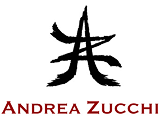Mimmo Di Marzio, Polyptychs of the unconscious, catalogo della mostra, Palazzo Frisacco, Tolmezzo (Udine).
What subtly hidden features do two zebras sparring in the savannah share with a catastrophic fire in a road tunnel? What do the apocalyptic collapse of the Twin Towers and the curling tentacles of an octopus have in common? What obscure rebus do the juxtaposition of the symmetrical planes of an eyeball, an arctic desert and disturbing presences from a nuclear laboratory allude to? Throughout his work, the poetics of Andrea Zucchi – a confirmed member of the new Italian painting scene – are fused with a perpetual visual displacement, a temporal re-phasing which makes it almost impossible to appreciate his individual works in one single simultaneous vision.
The constant disorientation into which Zucchi throws his viewers occurs on several levels of which the most apparent is the level of content. Yet this is not the only level which is able to translate the mysterious aura generated by representation. The contents are positioned according to a-narrative codes which allow the artist to propose highly surrealist poetic changes with an air of splendid unawareness. As Comte de Lautrèamont commented, the beauty of “the chance meeting of an umbrella and a sewing machine on a dissecting table” lies in the volatile, irresistible charm which derives from the coupling of two irreconcilable realities on a level which “apparently does not suit them”. Zucchi proceeds by free association of ideas to create improbable combinations of stories and images which have nothing in common with each other, but which, nevertheless, allow him to create new sensations. Far from conceptual velleity, at least at surface level, his compositions seem to be the direct result of a psychic automatism “dictated by thought, without any control by force of reason, and without any concern of an aesthetic or moral order” but which “undertakes to express, verbally, in writing, or by any other form, the true functioning of thought” (Breton).
The second level of disorientation is strictly formal. Zucchi’s metaphysical excursuses use the aesthetic language of new realism, a language which has led painting to explore the realms of other media such as photography, video, advertising and internet.
Expressing himself within a poetic context in which art coldly testifies an increasingly heterogeneous reality, a reality which is often confused with fiction and generally filtered by linguistic models which have been genetically changed by the media, Zucchi goes a dramatic step further to produce apparently realistic figures which are however described on a narrative level according to the analogue language of dreams.
His images assume a symbolic value, yet are disciplined by the irrational codes of the unconscious. This is true also – or perhaps especially – as far as the naturalistic elements employed by the artist are concerned. Zucchi often seems to use the most extreme features of natural iconography to set up coherent, almost archetypical, dialogues.
Yet his representations are wholly in-natural, almost as if his aim is to transfigure reality but not deny it. Zucchi’s compositions – which perhaps should more rightly be defined as contrajuxtapositions – assume that naturalism takes the form of “natural art” as defined by the Jungian artistic principle which focuses on an inspiring contact with Nature and a casual meeting with its forms. Thus, his archetypical-dreamlike universe sees the juxtaposing of elements of nature (mater and mater matris), everyday psychology – often taken directly from the media – and myth (which is sometimes revealed in extremely disturbing forms). Emblematic of this approach are the works which make up the Pseudo polyptych and which propose an Egyptian funeral mask as their central figure.
The esoteric world of Egypt is a recurring point of reference in the work of Zucchi. According to mythology, the riddle of the Sphinx – the guardian of the threshold which invites her guests to enter yet simultaneously blocks their way – is a symbol of initiation which every man who wants to look his mysterious guest in the eye must solve. Human, leonine and ambisexual, the Sphinx is a symbol of the androgynous, a joining of opposites in splendid esoteric synthesis.
Despite the decontextualizing force of the forms, contents and narrative codes of Zucchi’s work, there is still room for a third level which sees the viewer’s perception disoriented by more strictly linguistic canons.
By enclosing his “Proustian chaos” within a geometric compositional structure, the artist imposes a ‘mental’ rigour on the sensitive world he depicts. The neo-plasticistic grids which segment the images like parallel roads do not serve to recreate the real, but rather to deny singularity and individuality and impose reason. Yet, only because they are a direct – unfiltered – product of the collective unconscious are the rigourous super-egoistic structures able to nullify the uncontrollable emotion of feelings.
Thus, the other side of the artist (the Mondrian which is within Zucchi) feels an uncontrollable need to control the sensitive world with scientific reason, reducing it to mere geometry and a distant reminiscence of abstraction.

